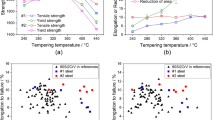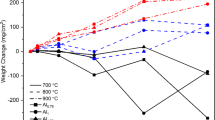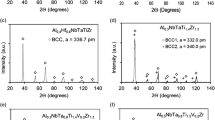The effect of annealing at up to 550°C on the electrical resistivity ρ and HB hardness of low-alloy alloys of the Al – Zr – Si system containing up to 0.3% Zr and 0.3% Si is studied. The Thermo-Calc software is used to analyze the phase composition of the system. The computed and experimental data are used to determine the lower and upper limits for heating of cast preforms from Al – Zr alloys (shaped castings and ingots). It is shown that heating below 400°C and above 450°C is not expedient, because it increases the duration of the annealing in the former case and lowers the hardening effect due to coarsening of the Zr-containing particles in the latter case.




Similar content being viewed by others
References
W. W. Anthony, F. R. Eliot, and M. D. Ball, Aluminum. Properties and Physical Metallurgy [Russian translation], Metalluigiya, Moscow (1989), 324 p.
N. A. Belov, A. N. Alabin, and A. Yu. Prokhorov, “Effect of zirconium additive on the strength and electrical resistivity of cold-rolled aluminum sheets,” Izv. Vysh. Uchebn. Zaved., Tsvetn. Met., No. 4, 42 – 47 (2009).
K. Sato, K. Yamauchi, Y. Hanaki, T. Kondo, and M. Yokota, High Conductive Heat-Resistant Aluminum Alloy, US Patent 4402763, publ. 09.06.1983.
E. Comoret and N. Masquelier, Aluminum Alloy Resistant to High Temperatures, Patent FR2981666, publ. 25.04.2013.
P. Uliasz, T. Knych, A. Mamala, and B. Smyrak, “Investigation in properties’ design of heat resistant AlZrSc alloy wires assigned for electrical application,” in: Aluminum Alloys: Their Physical and Mechanical Properties, DCM (2008), pp. 248 – 255.
N. A. Belov, A. N. Alabin, and A. R. Teleuova, “Comparative analysis of alloying additives as applied to production of heatresistant aluminum-base wires,” Metalloved. Term. Obrab. Met., No. 9, 54 – 58 (2011).
T. Knych, M. Piwowarska, and P. Uliasz, “Studies on the process of heat treatment of conductive AlZr alloys obtained in various productive processes,” Arch. Metall. Mater., 56, 685 – 692 (2011).
K. E. Knipling, D. C. Dunand, and D. N. Seidman, “Precipitation evolution in Al – Zr and Al – Zr – Ti alloys during isothermal aging at 375 – 425°C,” Acta Mater., 56, 114 – 127 (2008).
K. E. Knipling, R. A. Karnesky, C. P. Lee, et al., “Precipitation evolution in Al – 0.1Sc, Al – 0.1Zr and Al – 0.1Sc – 0.1Zr (at.%) alloys during isochronal aging,” Acta Mater., 58, 5184 – 5195 (2010).
N. A. Belov, A. N. Alabin, A. Yu. Prokhorov, and N. V. Skvortsov, “Effect of intermediate annealing on the electrical resistivity and strength of wire from low-alloy aluminum alloys of the Al – Zr – Fe – Si system,” Metalloved. Term. Obrab. Met., No. 4, 14 – 19 (2012).
T. Sato, A. Kamio, and G. W. Lorimer, “Effects of Si and Ti addition on the nucleation and phase stability of the Ll2 -type Al3Zr phase in Al – Zr alloys,” Mater. Sci. Forum, 217 – 222, 895 – 900 (1996).
V. S. Zolotarevskii and N. A. Belov, The Physical Metallurgy of Castable Aluminum Alloys [in Russian], MISiS, Moscow (2005), 376 p.
L. F. Mondolfo, Structure and Properties of Aluminum Alloys [Russian translation], Metallurgiya, Moscow (1979), 640 p.
W. Lefebvre, F. Danoix, H. Hallem, et al., “Precipitation kinetics of Al3(Sc, Zr) dispersoids in aluminum,” J. Appl. Compd., 470, 107 – 110 (2009).
N. A. Belov, A. N. Alabin, and A. Yu. Prokhorov, “Electrical resistance and strength of cold rolled sheets of aluminum alloys containing up to 0.64 wt.% Zr,” in: Proc. 12th Int. Conf. on Aluminum Alloys, Spt. 5 – 9, 2010, Yokohama, Japan, The Japan Inst. of Light Metals (2010), pp. 1107 – 1112.
The work has been performed with support of Grant NRF 14-19-01033 and of the Grant of the President of the Russian Federation for Supporting the Leading Scientific Schools (NSh-9899.2016.8).
Author information
Authors and Affiliations
Corresponding author
Additional information
Translated from Metallovedenie i Termicheskaya Obrabotka Metallov, No. 9, pp. 16 – 20, September, 2016.
Rights and permissions
About this article
Cite this article
Alabin, A.N., Belov, N.A., Korotkova, N.O. et al. Effect of Annealing on the Electrical Resistivity and Strengthening of Low-Alloy Alloys of the Al – Zr – Si System. Met Sci Heat Treat 58, 527–531 (2017). https://doi.org/10.1007/s11041-017-0048-6
Published:
Issue Date:
DOI: https://doi.org/10.1007/s11041-017-0048-6




